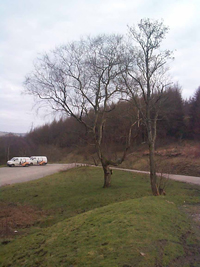Historic Landscape
Characterisation
Merthyr Tydfil
072 Waunwyllt, Pen-y-Lan and Graig Gethin
HLCA 72 Waunwyllt, Pen-y-Lan and Graig Gethin Agricultural landscape of dispersed post-medieval settlement associated with upland sheep farming; irregular evolved field pattern of drystone walled-enclosures largely hidden in forestry; Ancient Woodland and 20th century forestry; extractive landscape associated with the steam coal trade.
Summary
A former agricultural landscape of dispersed post-medieval settlement, dry stone walls and sheep pens with areas of Ancient Woodland (now dominated by 20th century conifer plantations), and an important extractive element associated with steam-coal production.
Historical background
The historic landscape area of Waunwyllt, Pen-y-Lan and Graig Gethin comprises an area of post-medieval agricultural holdings and Ancient Woodland to the south of Cwm Canaid and Upper Abercanaid, now engulfed by coniferous forestry plantations, part of the Gethin Woodland Park. The area was associated with the development of the 'steam coal' trade (ie coal specific to the needs of the steamship and navigation companies. Specifically Robert Thomas's level at Waunwyllt (1828), and later within the adjacent area (HLCA 017) that of Lucy Thomas at Graig pit, which exploited the 'steam' coal of the Four Foot seam. The main workings of Gethin were located in the lower lying area to the east within the adjacent transport corridors of HLCAs 079, and 014. The workings at Graig were further developed by the Plymouth Iron Company, while Cyfarthfa developed workings at Gethin.
Waunwyllt and Penylan formed part of the Plymouth or St Fagans Estate (Robert Henry Clive on the 1850 tithe), while the area also contains the holding of Graig, owned by one Margaret Morgan in 1850, and parts of the adjacent holdings of Abernant Gethin, and Pen-rhiw'ronen, which belonged to the Dynevor Estate during the 19th century. Cartographic material indicates that the holdings of Penylan and the Graig, in particular, in addition to Abernant Gethin and Pen-rhiw'ronen were characterised by irregular evolved field patterns associated with post-medieval farmsteads; the field pattern would suggest that these farms were the older holdings of the area. Waunwyllt Farm, with its larger enclosures was likely to be a later post-medieval (18th century?) addition, taking former 'Waun' originally associated with Penylan. The earliest estate map coverage of the area is of 1766 (Plymouth Iron Company, St Fagans Estate), which detailed holdings of Penylan and Waunwyllt. Later maps 1799-1915 allow the development of the area to be charted, however little real change is noted until the abandonment of the area's farms and the creation of the forestry during the latter half of the 20th century. The layout of Waunwyllt Farm was altered slightly following the construction of the adjacent Abernant Tunnel and Cutting for the extension of the Vale of Neath Railway to Merthyr Tydfil in 1853.
The area contains numerous features associated with sheep farming (ie sheep folds). Waunwyllt Farm is strongly associated with the development of the 'steam coal' trade (ie coal specific to the needs of the steamship and navigation companies; specifically Robert Thomas's level at Waunwyllt. Several features in the area may be related to these early workings, such as the rectangular structure noted to the south of the farmstead on the first edition 6-inch OS map (1875) and an old level shown on the 1915 revision (1922 OS map). Other extractive features recorded on the 1875 OS 6-inch map included surface workings west of Upper Aber-canaid, and a number of old quarries on the north and the west slopes of Pen-y-lan Hill. Also extant by 1875 was the reservoir, Webber's Pond, presumably associated with the initial water-balance lift at Gethin No. 2 Pit (the site of lies within the adjacent HCLA 075) and at least two airshafts. The 1901 OS 6-inch map also detailed an old level just north of Pen-rhiw'ronen Farm, probably dating to the period 1875-1898. Further industrial expansion in the area would appear to date to some time after 1898 with the development of workings along Nant Graig to the South of Pen-y-lan. Waunwyllt Colliery with its level and the tramway connection in the Nant Graig valley to the Castle Pit Railway/GWR and Rhymney Joint Railway (HCLA 079), and Castle Level (coal), part of the extensive Castle Pit complex with its rail network are other examples (3rd edition 6-inch OS map, 1922, revised 1915). The latter map also indicated an earlier disused phase including an old level near Pen-y-lan, a disused upper section of tramway in the Nant Graig valley leading to possible shaft, and two further old coal levels south of Graig Gethin. The area, which includes a parcel of Ancient Woodland on the North Side of Nant Graig, has seen extensive afforestation during the 20th century.
